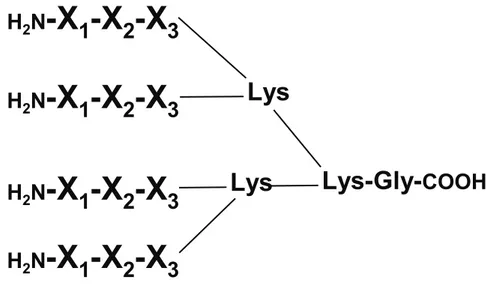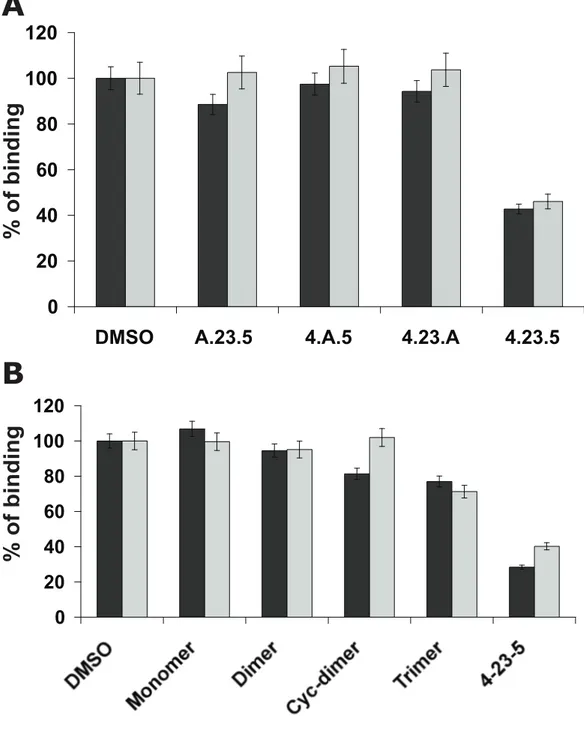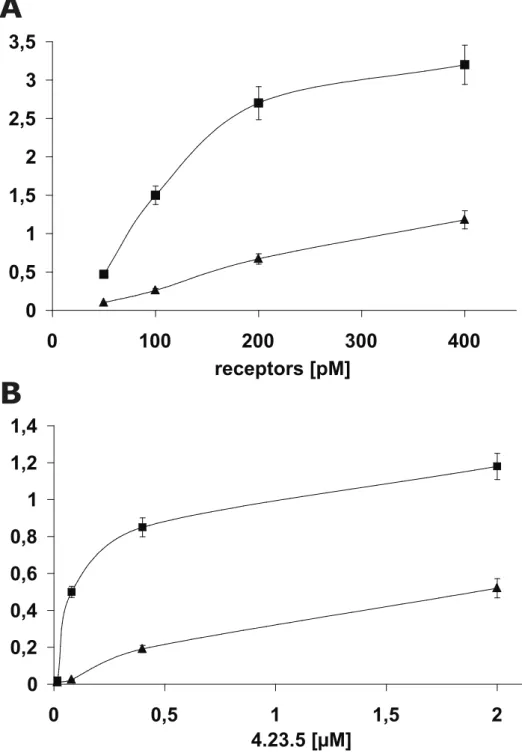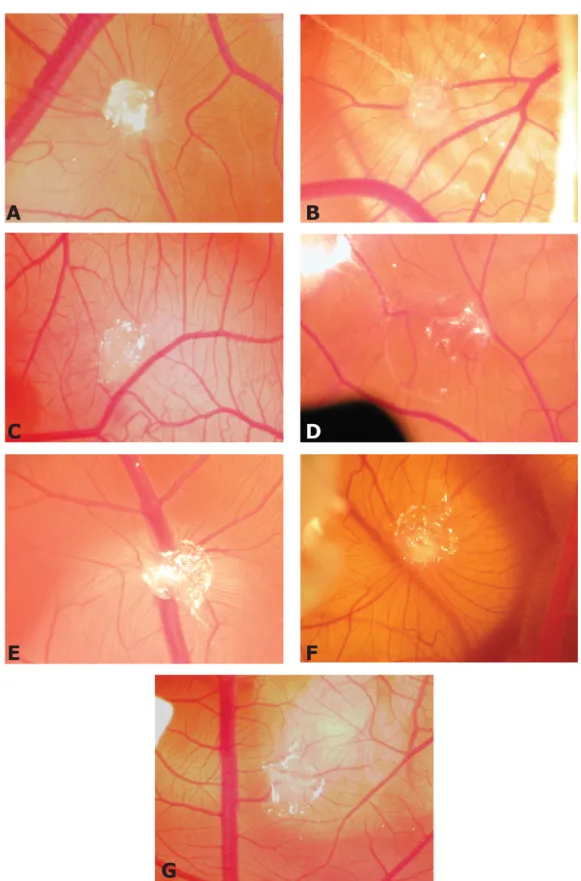SUPPLEMENTAL EXPERIMENTAL PROCEDURES.
Synthesis of combinatorial tetrameric tripeptide library - For the library synthesis, 30 different blocks were utilized (Supplemental Table S1), and a theoretical number of 27,000 peptides was generated, split in 30 separate pools of 900 peptides each. The synthesis was manually carried out on a 300 µmoles scale following standard Fmoc methodologies and using PyBOP as coupling agent (1).
A typical acylation/deprotection cycle consisted of a 15 minutes coupling step (0.25 M amino acid solutions in situ activated with PyBOP and DIEA) and a 10 minutes deprotection step with 30% piperidine in DMF. Peptide mixtures were then detached from the corresponding resins by treatment with a cleavage cocktail containing TFA-TIS-H2O (95:2.5:2.5, v/v/v) for 2h at RT, then they were lyophilized twice, dissolved in DMSO at 5 mg/mL and stored at –80°C until use. Assuming an average molecular weight of 2128 amu for the tetrameric tripeptides (see the legend of Supplemental Fig. S1), a theoretical 2.6 µM concentration for each library component was achieved. No specific characterizations were performed at this stage given the high complexity of the resulting sub-libraries (900 components).
After the first screening round, the selected sub-library carrying the D-Glutamic acid (D-Glu, building block 4) on the N-terminus, was prepared following the same synthetic procedure. A theoretical number of 900 molecules arranged in 30 pools of 30 peptides each was thus generated.
Characterization at this step on selected sub-libraries was achieved by LC-MS using an LC-MS system equipped with a Surveyor HPLC, comprising a quaternary pump and a PDA detector, and an LCQ Deca Ion Trap mass spectrometer (ThermoFisher). For the analyses, C18 narrow bore 30x1 mm ID Biobasic column (ThermoFisher) equilibrated at 200 µL/min with 5% CH3CN, 0.05% TFA were used. Analyses were carried out applying a gradient of CH3CN, 0.05% TFA from 5% to 70% over 90 minutes. The mass spectrometer mounted an ESI source maintained at 320 °C and 4.2 kV. Spectra in positive mode were continuously acquired between 200 and 2000 amu. Mixtures were detached from the resin as described previously and the products were stored in DMSO at 5 mg/mL concentration. The 30 peptides composing the sub-library identified in the second screening round and carrying the Cys(Bzl) (building block 23) on the known position, were prepared in parallel as single molecules. After cleavage from the resin and lyophilisation, the peptides were all characterized by LC-MS using a narrow bore 30x1 mm ID Biobasic column equilibrated at 200 µL/min with 5% CH3CN, 0.05% TFA. Analyses were carried out applying a gradient of CH3CN, 0.05% TFA from 5% to 70% over 13 minutes. Peptides were first tested in the competition assay as crude products, then the active molecules and those assumed as negative controls were purified by semi-preparative RP-HPLC using a 25x1 cm C18 column (Phenomenex, Torrance, CA, USA), characterized by LC-MS and re-submitted to the competition assay. The active peptides were tested in cellular and in vivo assays as acetate salts in order to prevent the cytotoxic effects of the TFA present as counterion. To this aim, peptides were dissolved in 0.1 M CH3COOH and repeatedly lyophilized. Reagents for solid phase synthesis were from Chem-Impex or Novabiochem; solvents were all from LabScan (Dublin, Ireland). Reagents for peptide cleavage were from Sigma-Aldrich (Milan, Italy). LC-MS systems and columns for LC-LC-MS analysis were from ThermoFisher (Milan,Italy).
REFERENCES
SUPPLEMENTAL TABLE S1. List of building blocks used to assemble the peptide library.
code 3-letters code building block
1 D-Ala D-Alanine
2 D-Asp D-Aspartic acid
3 D-Val D-Valine
4 D-Glu D-Glutamic acid
5 L-Cha L-Cyclohexylalanine 6 D-Phe D-Phenylalanine 7 D-Thr D-Threonine 8 D-Met D-Methionine 9 D-Cys(Acm) D-Cysteine(S-acetamydomethyl) 10 D-Lys D-Lysine 11 D-Tyr D-Tyrosine 12 D-Pro D-Proline 13 D-Leu D-Leucine 14 D-His D-Histidine 15 D-Gln D-Glutamine 16 D-Trp D-Triptophan 17 D-Arg D-Arginine 18 D-Asn D-Asparagine 19 D-Ile D-Isoleucine
20 D-Arg(Tos) D-Arginine(NΓ-Tosyl)
21 D-Ser D-serine 22 L-Cys(Acm) L-Cysteine(S-acetamydomethyl) 23 L-Cys(Bzl) L-Cysteine(S-benzyl) 24 L-Cys(p-MeBzl) L-Cysteine(S-pmethyl-benzyl) 25 L-Cys(tBu) L-Cysteine(S-tert-butyl) 26 L-Met(O) L-Methionine-sulphone 27 L-Met(O)2 L-Methionine-sulphoxide 28 L-Glu(β-OAll) L-Glutamic acid-(β-allyl)
29 β-Ala β-Alanine
30 Gly Glycine
Building blocks 9, 20, 22, 23, 24, 25, 26, 27, and 28 bear side chain protections that are not removed by TFA treatment, so that unnatural residues are generated. The tosyl group on building block 20 stands for p-toluenesulfonate.
SUPPLEMENTAL TABLE S2. Characterization of the 30 single peptides tested in the last screening. Monomer N° Theoretical MW (amu) Experimental [M+2H]2+ Experimental MW (amu) Purity (%, HPLC) 1 2033.46 1017.8 2033.6 87.5 2 2209.50 1105.6 2209.2 88.9 3 2145.66 1074.0 2146.0 95.3 4 2265.58 1133.9 2265.8 97.5 5 2362.02 1182.1 2362.2 90.5 6 2337.82 1169.8 2337.6 86.0 7 2153.54 1077.7 2153.4 88.7 8 2273.90 1137.9 2273.8 83.7 9 2446.02 1224.1 2446.2 84.5 10 2261.82 1132.0 2262.0 89.0 11 2401.82 1201.8 2401.6 90.4 12 2137.58 1069.6 2137.2 91.0 13 2201.78 1101.9 2201.8 83.9 14 2297.70 1150.0 2298.0 86.2 15 2261.66 1131.9 2261.8 89.0 16 2493.98 1248.0 2494.0 79.8 17 2373.90 1188.1 2374.2 85.9 18 2205.54 1103.8 2205.6 89.1 19 2201.78 1102.0 2202.0 95.2 20 2990.62 1496.2 2990.4 82.9 21 2097.46 1049.8 2097.6 88.6 22 2446.02 1224.0 2446.0 93.0 23 2522.22 1262.1 2522.2 96.1 24 2642.38 1322.2 2642.4 88.5 25 2386.22 1194.1 2386.2 86.3 26 2337.90 1169.8 2337.6 72.5 27 2401.90 1201.9 2401.8 70.4 28 2425.94 1213.9 2425.8 90.1 29 2033.46 1017.7 2033.4 89.2 30 1977.34 989.7 1977.4 96.5
Monomer numbers are the same as in Table S1. Theoretical MWs are calculated as average. MWs were obtained by LC-ESI-MS analysis of the crude products and were derived by the experimentally determined [M+2H]2+ values (3rd column). Purity of products was determined by integrating chromatogram peaks on the 215 nm trace and excluding peaks within the first 5 minutes of the run. Data of the 4-23-5 peptide are in bold.
SUPPLEMENTAL TABLE S3. Analogues of the 4-23-5 tetrameric tripeptide.
Peptides Theoretical
MW (amu) Experimental [M+2H]2+ Experimental MW (amu) (%, HPLC) Purity
4-A-5 1873.28 937.7 1873.4 >99 4-23-A 2033.45 1017.8 2033.6 >99 A-23-5 2129.89 1066.0 2130.0 >99 Monomeric 4-23-5 493.63 ND 493.6 >99 Dimeric 4-23-5 1154.47 578.2 1154.4 >99 Trimeric 4-23-5 1758.25 880.2 1758.4 >99 Cyclic-Dimeric 4-23-5 1358.74 680.4 1358.8 >99 21-1-5 1705.13 853.6 1705.2 >99
Synthetic peptides were obtained as described for the other library components and were all purified by RP-HPLC before characterization and testing. A-23-5, 4-A-5 and 4-23-A refer to variants of the selected multimeric peptide with L-alanine substituting (D)Glu, (L)Cys(Bzl) or (L)Cha, respectively. The peptide 21-1-5 is a tetrameric tripeptide used as a negative control in all assays and contains the sequence (D)Ser-(L)Ala-(L)Cha.
H
2N
-X
1
-X
2
-X
3
Lys
Lys-Gly-
COOH
Lys
H
2N
-X
1
-X
2
-X
3
H
2N
-X
1
-X
2
-X
3
H
2N
-X
1
-X
2
-X
3
Figure S1. Schematic representation of the multimeric structure of the library components.
The polylysine core was achieved by two subsequent couplings with Fmoc-L-Lys(Fmoc)-OH, doubling the amino acid excess after each step. Gly and Lys stand for glycine and lysine, respectively, while the X represents random positions. The average library MW (2128 amu) was calculated by summing the average MW of building blocks reported in Table S1 (138.2 amu) multiplied by 12, to that of the polylysine scaffold (458 amu).
Figure S2. Sequence and structure of tetrameric 4-23-5 peptide are crucial for its inhibitory
property.
The inhibitory properties of 4-23-5 analogues were evaluated in competitive ELISA assays for PlGF (5 ng/mL)(black bar) and VEGF-A (10 ng/mL)(grey bar) binding to coated Flt-1 receptor (0.5 µg/mL). A) Alanine-scanning tetrameric analogues A-23-5, 4-A-5 and 4-23-A, and (B) the monomeric, dimeric, cyclic-dimeric (Cyc-dimer) and trimeric analogues were tested at 50 µM. In both experiments, DMSO refers to the absence of competitor. Tetrameric 4-23-5 was used at 12.5 µM. The results represent the average of three independent experi-ments. Error bar represents the SD.
SUPPLEMENTAL FIGURE S2.
A
B
% of binding
0 20 40 60 80 100 120DMSO A.23.5 4.A.5 4.23.A 4.23.5
% of binding
0 20 40 60 80 100 120 DMSO Monomer Dimer Cyc-dimer Trimer 4-23-5Figure S3. Dose-dependent binding of human and mouse Flt-1 receptors to 4-23-5 peptide in
ELISA-based assays. A) 4-23-5 peptide was coated at 20 µM on 96-well ELISA plates. Human (◼) or mouse (▲) Fc/Flt-1 receptors were added at concentrations ranging between 50 and 400 pM. B) 4-23-5 peptide was coated at concentrations ranging between 0.016 and 2.0 µM. Human (◼) or mouse (▲) Fc/Flt-1 receptors were added at fixed concentration (125 pM). Results are representative of the average of three independent experiments. Error bar represents the SD.
SUPPLEMENTAL FIGURE S3
A
B
0 0,2 0,4 0,6 0,8 1 1,2 1,4 0 0,5 1 1,5 2 4.23.5 [µM] 0 0,5 1 1,5 2 2,5 3 3,5 0 100 200 300 400 receptors [pM]Figure S4. Representative pictures of CAM assay. CAMs were implanted with alginate
beads containing: VEGF (150 ng/embryo) in the absence (A) or in the presence of 0.25 nmoles of 4-23-5 (C) or 21-1-5 (E) peptides; PlGF (250 ng/embryo) in the absence (B) or in the presence of 0.25 nmoles of 4-23-5 (D) or 21-1-5 (F) peptides; the vehicle (G). CAMs were photographed three days after the implant (Original Magnification x5).



